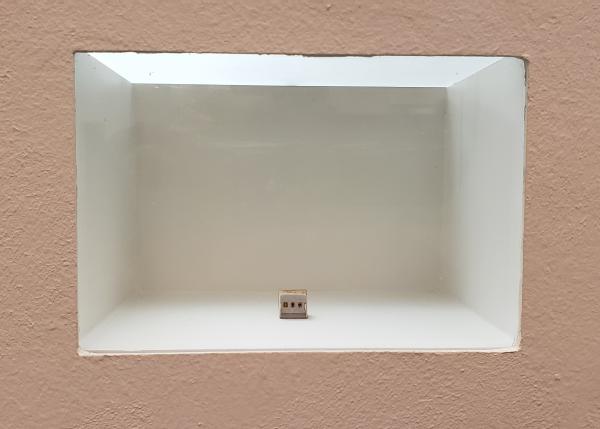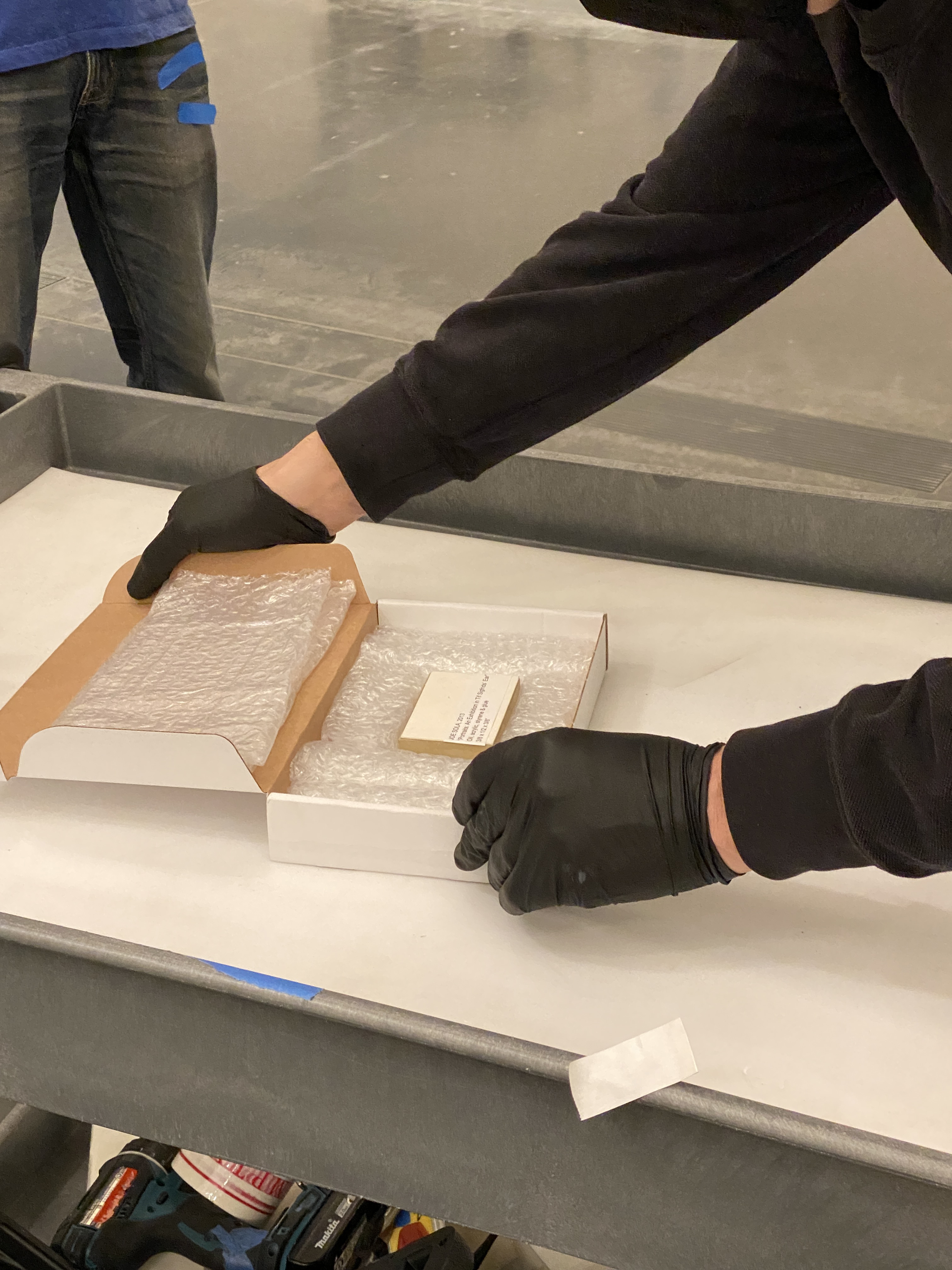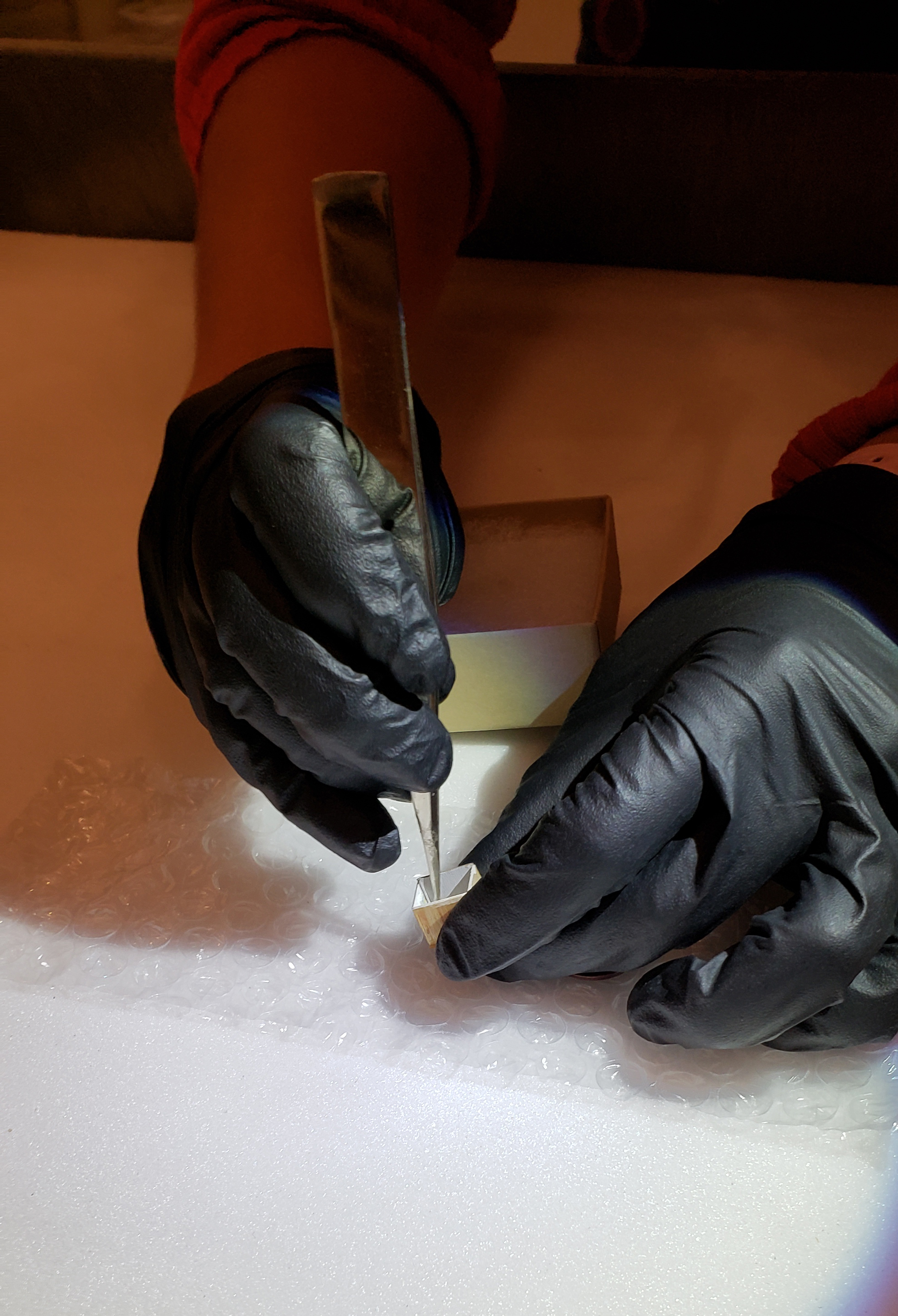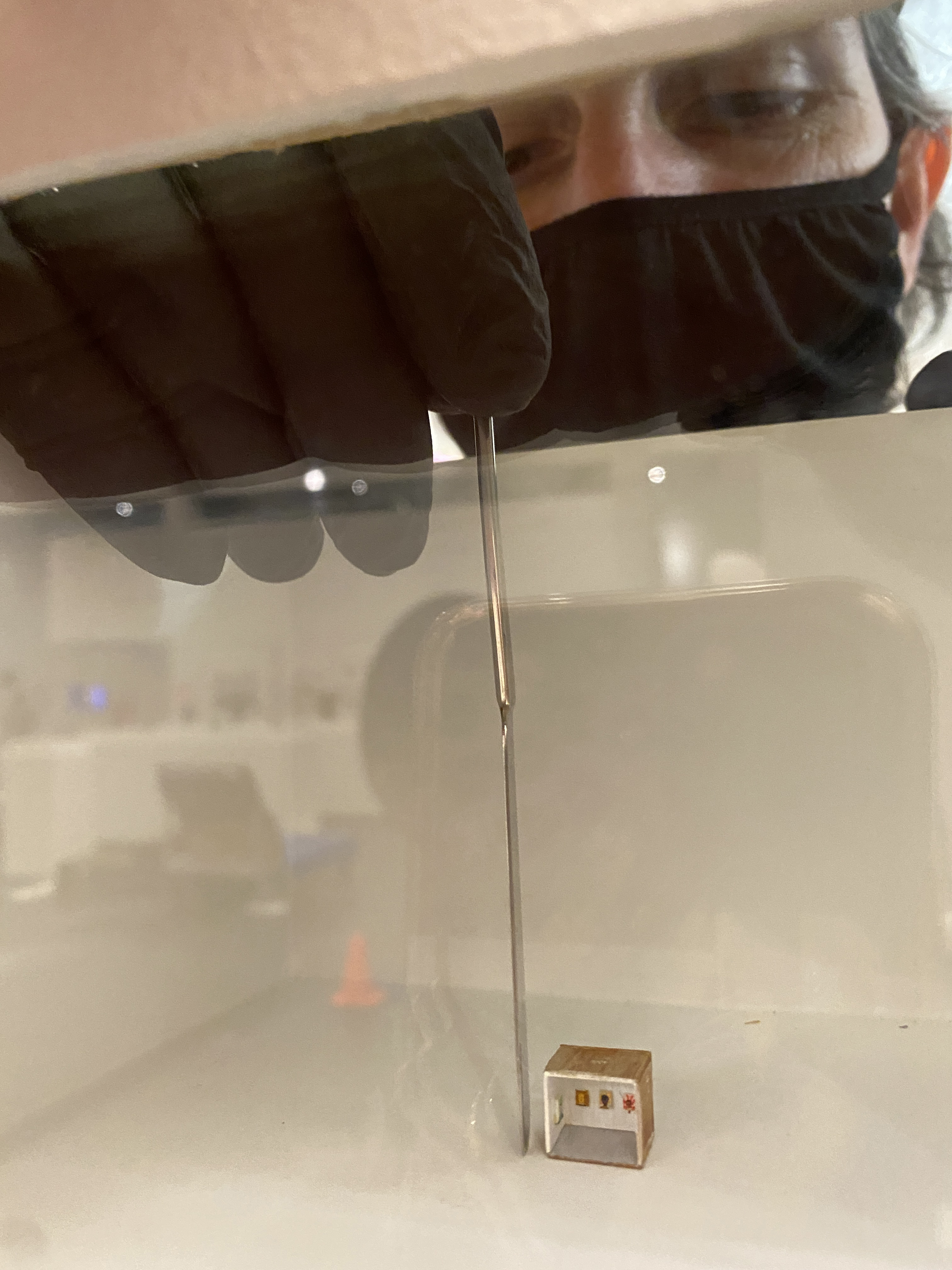As a career art preparator, one of the most exciting perks of the job might be the chance to handle priceless works by iconic artists—household names, artists I studied in college who inspired me to be a better artist. As a child, visiting LACMA on our annual school field trips was the highlight of my year, a chance to see golden treasures and mummies from ancient Egypt. To me, LACMA was a Shangri-La for my young creative mind. So, you could only imagine the joy I felt when I learned that my friend Joe Sola’s work Portraits: An Exhibition in Tif Sigfrids’ Ear (2013) was to be included in curator José Luis Blondet’s exhibition NOT I: Throwing Voices (1500 BCE–2020 CE) at the institution I hold in such high regard. The artwork is a 1 × 1/2 × 1/2 in. miniature gallery of oil paintings—the portraits are painted under a microscope. The paintings are so tiny that Joe had to invent a tool to apply the paint, for even the tip of an eyelash was too large to work under the scope. His solution was to meticulously file down a .12mm acupuncture needle with an emery cloth to the most minute tip and then use it to apply the paint under a microscope. As Joe described the process, “the result is a tool that allows the material to reveal the work.” He then displayed the work in the ear of gallerist Tif Sigfrids.
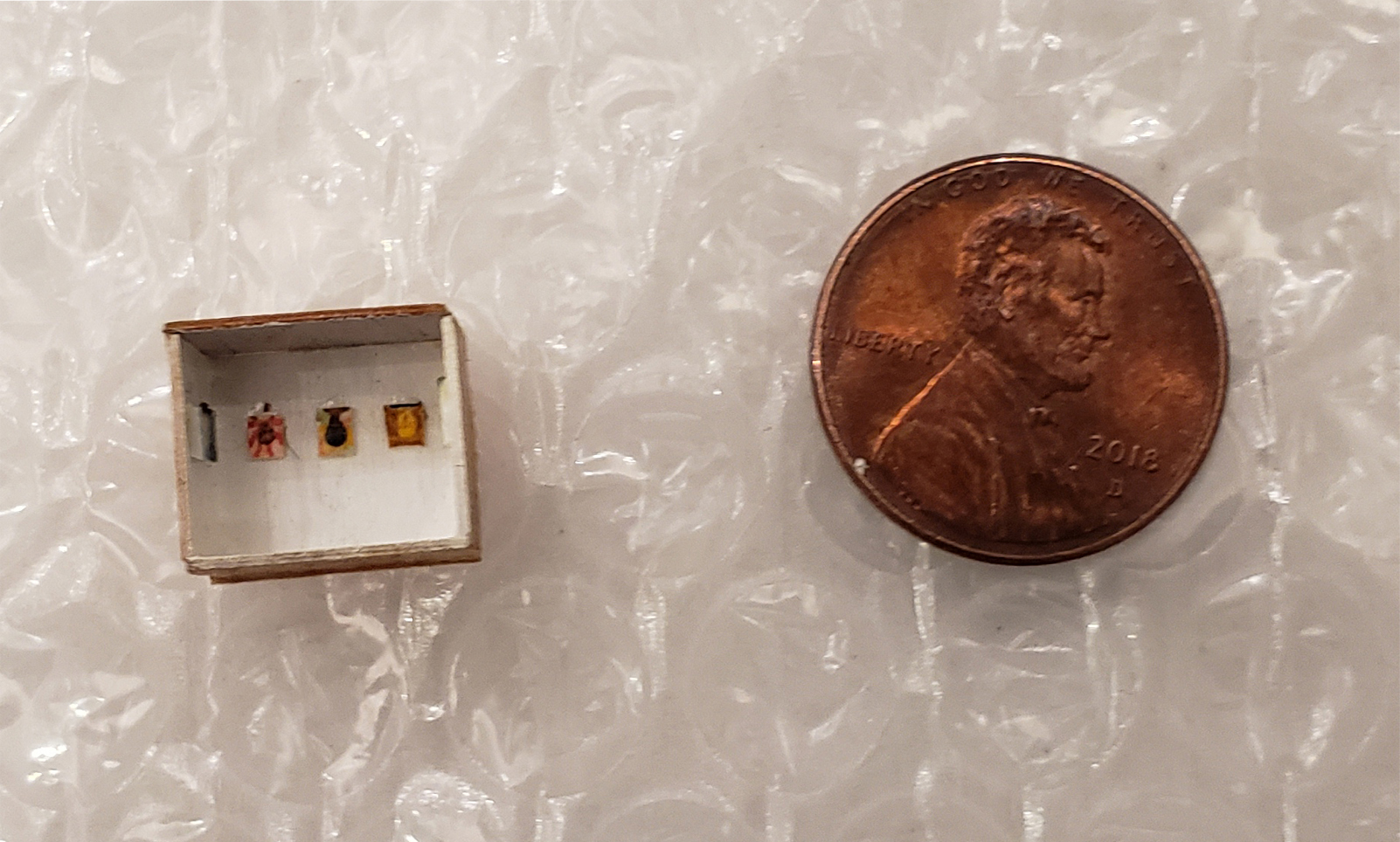
The first time I met Joe Sola was at a small house gathering in Echo Park. It was during those early years in the 2000s when you could still drink warm Pabst Blue Ribbon all night for 20 dollars at the Little Joy bar, crammed in like sardines among the humid haze of cigarette smoke and sweat. The home was a beautiful Craftsman bungalow right on Echo Park Lake. Hidden from the street behind an overgrowth of palms and hedges, you would have had no idea there was a home behind it if not for the small flight of steps and a faded house number stenciled on the gate.
I remember feeling awed when I first swung open the creaky picket and passed through the hedge into the property. It was like having been zapped back in time to the glitzy days of old Hollywood into this little Noir oasis hidden from the honking congestion of the 101 freeway. Being a very shy introverted person, it has always been hard for me to feel comfortable around new people. But immediately upon entering the party I was greeted by the hosts and introduced to all the guests as if I were one of their oldest friends, which put me at ease. It turned out that this group of young 30-somethings I had just met were all talented local artists, and among them was Joe, his infectious laughter a welcoming handshake.
The process of installing any work is never as straightforward as it appears and Joe’s piece was no exception. Whether it be paintings, sculpture, textiles, or ephemera, there are multiple levels to the process and best practices must always be followed. Once it is determined that we may proceed with the preparation for installation the next step is to coordinate with the registrar, the conservator, and sometimes the curator to determine a game plan for the installation. Next, all parties involved come to a consensus for the safest method of transport.
In this case, with senior assistant registrar Elspeth Patient’s blessing, we were able to retrieve Joe’s work from its secure cabinet and transport it via Rubbermaid cart to objects conservator Abby Duckor. After carefully unpacking the artwork from its box, Abby performed the condition check in place on the Rubbermaid as we marveled at her precision and patiently waited for her assessment.
With the inspection completed and recorded, Abby delicately removed some unwanted fuzz spotted trespassing in the tiny gallery, most likely deposited there from its packing material. We then proceeded with the careful dance of coordinating the presence of essential personnel and the physical installation of the artwork.
I suppose when we visit an exhibition, we are usually accustomed to the standard layouts of a gallery with paintings and prints hung on the walls and sculpture and objects placed on pedestals within the gallery. But with this show, José Luis and the exhibition designers brilliantly chose to take a fun and whimsical approach to the design, one of them being the installation of Joe’s Portraits: An Exhibition in Tif Sigfrids' Ear within a niche cut in the gallery wall and faced with plexiglass, a sort of curio case for the artwork. This presented some challenges to the installation, the first being the safe transportation of the artwork through a restroom in the Resnick Pavilion to the service entrance that led into the narrow passageway within the cavity of the wall. Second, the passageway was too narrow for our cart to fit though so art prep, conservation, and registration mutually agreed that it would be okay to hand-carry the artwork packed in its container.
Abby, Elspeth, and I made our way safely to the point of installation within the wall to the object case—a wooden box mounted expertly to the inner wall and lit from above. With José Luis on the opposite side of the wall to eye the perfect placement within the niche, and Abby holding the small box containing Joe’s seminal work, I delicately placed the artwork within its case. It was now time for the curator to guide its placement—but one problem—he could not hear anything I said from the inside of the wall. That was when modern technology came to the rescue. Elspeth called José Luis on her cell phone and we communicated over a direct line. Finally, as I contorted and struggled to achieve the proper angle for my lanky arms to maneuver within the case, I delicately nudged the artwork into its final position with a precision conservation tool and got the thumbs up from José Luis. With final placement achieved, all that was left was a little house cleaning, which consisted of the careful removal of any stray specs of dust and particles collected in the case. The case was then closed.
With Joe’s work now on display in José Luis’s wonderful exhibition, I think back on the times I visited LACMA those many decades ago. How I was so inspired by the creativity and talent displayed within its walls and how Joe Sola's work will serve to inspire a new generation.
NOT I: Throwing Voices (1500 BCE–2020 CE) is on view through July 25, 2021 in LACMA’s Resnick Pavilion. All visitors, including LACMA members, must purchase or reserve an advance timed-entry ticket.



